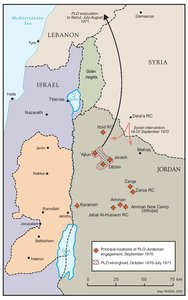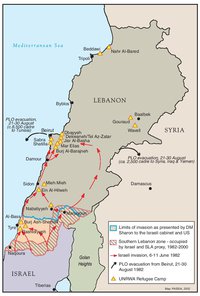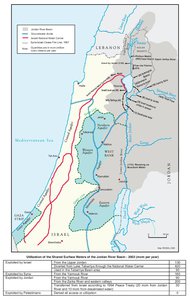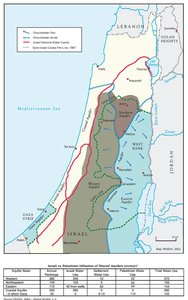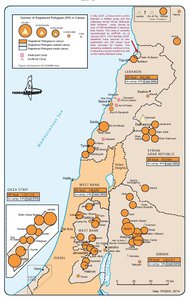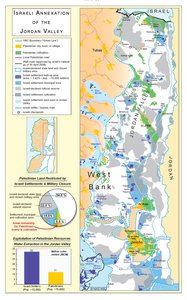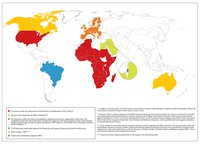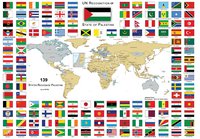THE PLO, 1965–1971
Map Details
By the early 1960s, a new generation of Palestinians had emerged, incensed by the injustices inflicted upon
them and frustrated by the failings of the Arab states amongst which they were dispersed. Fear of Israeli
retaliation and domestic agitation prevented the Arab governments from fostering the independence of the
Palestinian political movements they formed, such as Fateh. Instead, in 1964, the Arab League formed the
Palestine Liberation Organization (PLO). Ostensibly under Nasser’s patronage, the PLO - headed by
Palestinian Ahmed Shuqeiri - professed an aim of, “organizing the Palestinian people and enabling them to
play their role in the liberation of their country,” but initially remained subservient to the established Arab
leaders.
In late 1964, Yasser Arafat’s Fateh movement took the initiative and launched its first guerilla attack on
Israel. The next year, Fateh ran 39 such operations and began recruiting volunteers from the refugee
camps. After the 1967 War and the defeat of the Arab armies, many saw the ongoing Palestinian efforts as
the only sign of Arab resistance and more volunteers joined as numerous other groups were formed.
Israel’s destruction of West Bank and Gaza networks following the war left Jordan as the main base for
guerilla forces, which accrued a degree of virtual autonomy in a number of border villages.
Some 78 guerilla attacks were launched across the Jordan River in as many days in early 1968, prompting
a massive Israeli retaliation on 21 March5 when 15,000 Israeli troops participated in the attack on Karameh.
Anticipating the offensive, Arafat ordered his 250 Fateh fighters to resist alongside 80 other guerillas and a
division of the Jordanian army. The guerillas lost 116 men, the Jordanians 61, but at Karameh (which
means ‘dignity’ or ‘honor’) a vast Israeli force met real resistance: 28 soldiers were killed and a legend was
born. In the 48 hours following the battle, 5,000 recruits enlisted with Fateh. Other movements were also
inundated with volunteers and Yasser Arafat achieved near mythical status. He rode a wave of popular
endorsement to wrest control of the PLO in early 1969 and late that year was being seen not only as the
leader of the resistance but, in many instances, of the Palestinian people.
By 1970, PLO forces were operating their own police, courts, trade unions, media and armed forces
throughout the Jordanian refugee camps and beyond. As an umbrella organization whose constituent parts
ranged from revolutionary Marxists to separatist nationalists, the PLO was at once broad-based and
fractious. The tactics of the Popular Front for the Liberation of Palestine (PFLP) had, by 1969, drawn the
armed conflict firmly into the international arena, yet the same year Fateh was holding secret talks with
Israel in Paris. The presence of armed, often unruly, autonomous Palestinian forces posed a serious
challenge to the Hashemite regime. Then, in September 1970, the PFLP landed three hijacked airliners in
an airfield near Amman, released the passengers and, after making their case before the assembled
international media, blew up the aircraft. Humiliated by the display of his impotence, King Hussein felt
forced to finally impose his authority on the militias.
The next day, 16 September, the Jordanian army began its offensive, declaring martial law and using
artillery on PLO strongholds and camps. The ‘Black September’ civil war lasted until 27 September, leaving
over 3,000 dead and many camps and cities, incl. Amman, devastated. Syrian military intervention to aid
the PLO raised regional stakes and Cold War concerns, eventuating in Nasser’s mediation of an urgent
cease-fire agreement in Cairo. The War of 1970 reduced the PLO’s presence to the ‘Ajlun and Jerash
strongholds, from which - in July 1971 - Hussein finally ousted them, leaving a further 3,000 Palestinians
dead.
Arafat and his fighters fled to Lebanon, where the PLO set up its next headquarters. The ‘honeymoon’ in
Jordan had been brought to an end and Lebanon stood to become the next theater of conflict, as Israel
stepped up efforts to eliminate a Palestinian national movement that had proved itself highly capable and
had also exhibited its potential to divide as much as unite the Arab World.

